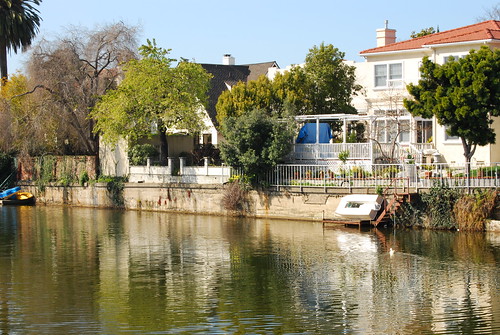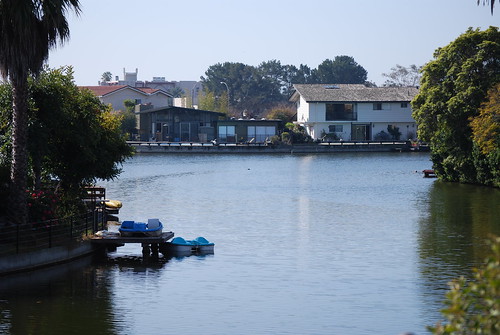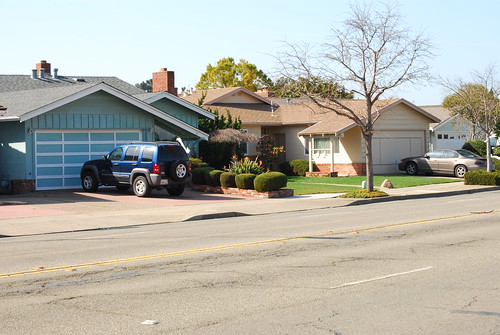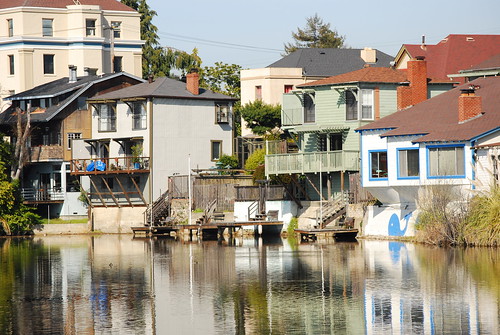Oakland has some venetian gondolas on Lake Merritt, but if you want to find a place in the Bay Area that feels (at least a bit) like Venice, you’ll do better heading across the estuary to Alameda’s lagoons, as I did one day late last week.
Unfortunately, unlike the canals of Venice, Italy (or the canals of Venice, California, for that matter), you won’t have much luck taking a long romantic stroll alongside these lagoons, because there are only a few spots where the public can reach the water’s edge. Most land on the shoreline is private property.
Also unlike the canals of the Venetian archipelago, these lagoons are neither ancient nor natural. In the mid 1950’s Alamedans, showing all the city planning wisdom of that era, voted to allow a developer to add 350 acres of landfill to the tidal flats south of Alameda’s town center, where a new neighborhood and a shopping center would be built (the Alameda Sun’s website has a dramatic but blurry aerial photograph from 1958 showing the new landfill). Stately Victorians on Alameda’s “Gold Coast,” which had previously been on bayfront property, now presided over these small lagoons instead, with views of other homes instead of ships and sailboats out on the bay.
One legacy of this sudden expansion of the island is that you still notice a stark difference in design as soon as you cross over the lagoons to the newer “South Shore” neighborhood. Whereas the older parts of Alameda have narrower 19th-century streets and pedestrian-friendly shopping districts, the more recent development 50 yards away is the epitome of late-50’s planning, with wider roads, numerous cul-de-sacs, drab ranch houses and a sprawling shopping mall.
The older neighborhoods of Alameda are full of graceful streets and homes like these:
Not all the houses are so grand, but even the small cottages in the Gold Coast are often beautifully designed:
Contrast those pictures with this streetscape on the opposite side of the lagoon (I assume these homes have front doors, but I’d be hard pressed to tell you where to find them — you might as well just enter through the garages instead):
I’m obviously not the first person to notice that houses from that era haven’t kept their appeal the way Victorians have (it’s humbling to realize that when these homes were built, it was Victorians that were considered dumpy and undesirable), but it’s not often that you see them in such proximity without being intermingled. If you stand in the cul-de-sacs on the landfill side of the lagoons and look at the ranch houses, you can often see prettier houses looming over them from the other side of the water — that’s how close these neighborhoods are.
This history is inscribed not only in the architecture and the street plans, but also in the embankments themselves. While the new homes have yards near the level of the water, the formerly bayside properties on the northern side of the lagoons have high, sturdy seawalls, built to withstand strong tides and erosive waves being blown across the bay.
Needless to say, the residents of the Gold Coast fought the landfill development mightily, but in the post-WWII era, when Alameda’s Naval Air Station was no longer a busy deployment site for the Pacific theater, Alameda’s population was declining and voters approved the landfill in order to boost the city’s prospects. Astonishingly, property owners along the erstwhile coastline were not compensated for their loss in any way, although some early plans had called for landfill all the way to their seawalls, as well as construction of a six lane highway through Alameda to a new transbay bridge, so the formation of the lagoons was considered a partial victory by opponents of the development.
Alameda Magazine published a long article in late 2007 about the fight over the development, which provides more history than I have here. There are now much stricter regulations protecting the shores of San Francisco Bay, and needless to say, a proposal like the South Shore development would be a nonstarter today, but reading about these episodes from recent history always makes me wonder which of today’s practices will look unthinkable 50 years hence (and conversely, which of today’s unthinkable practices will seem like no big deal in half a century).









16 Comments